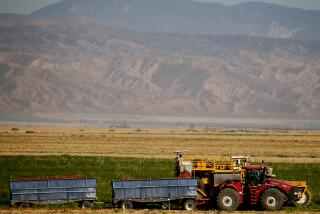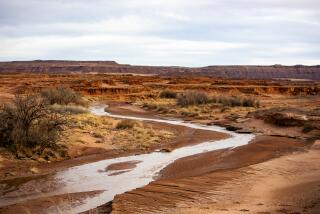Water: A New Cash Crop
- Share via
ROCKY FORD, Colo. — Ron Aschermann could barely eke out a living raising melons, cucumbers, tomatoes and other crops on his 300-acre farm. But quitting the business will earn him more than $1.2 million.
Aschermann and scores of other farmers on the high plains of southeastern Colorado are selling water, which once produced melons, to the Denver suburb of Aurora. The prairie will retake land that has long known the plow.
“Yeah, it’s not a healthy thing to do for the area, but let me tell you: Farming is not that great anymore either. These rural communities in almost any state you want to go into, they’re all getting smaller,” said Aschermann, 60, whose family has farmed in the area since 1911. “The best dollar for the asset right now is the water.”
The same thing is happening across the West as the nation’s fastest-growing region shifts more water from farms to thirsty cities. Billions of gallons changed hands last year in eight Western states, and even more will flow in years to come. California recently approved a 75-year shift of water from desert farms to San Diego.
Colorado’s Arkansas River Valley serves as a cautionary example for the West’s burgeoning water market. For a onetime payment of $18 million, Aurora bought water to flush toilets and grow flowers in new homes, and a faded farm region will be dealt another blow. What was once the town’s pride, a 13-mile ditch that settlers dug by hand shortly after the Civil War, will be nearly drained. When the water leaves, more jobs and local businesses are expected to dry up as well.
“Westwide, over the next 25 to 50 years, you will clearly see additional examples of what’s happening in the Arkansas Valley,” said Bennett Raley, a Denver water lawyer who is now the Bush administration’s point man for Western water issues.
Across the Arkansas River from Rocky Ford, Carl McClure, 65, president of the local farmers union, offers a tour of what happened to a neighboring county that sold most of its water to Colorado Springs and other cities.
McClure noses his pickup past Crowley County’s closed railroad stations, empty storefronts and a shuttered car dealership. An alfalfa field has disappeared beneath the Arkansas Valley Correctional Facility, a medium-security state prison. McClure retired after working there 12 years to supplement his farm income.
“This is what replaces farms when you take the water away,” McClure said, gazing at the prison’s floodlights and chain-link fence.
Down the road is the newer Crowley County Correctional Facility. Together, the two prisons house more than 2,000 male inmates, a group that has grown to represent nearly half the county’s population.
“It can be very depressing,” McClure said. “Crowley County is a prime example of what shouldn’t happen.”
It’s a fate that California’s Imperial Valley, the state’s poorest region, hopes to avoid. In October, the desert farm region, the largest single user of Colorado River water, narrowly agreed to ship some of its supply to San Diego for $3.5 billion over 45 years -- the biggest sale of its kind in U.S. history.
Imperial found itself under extraordinary and unprecedented pressure to sell. The U.S. Bureau of Reclamation threatened to take away some water that it deemed the desert farmers were wasting.
The water sale is designed to give Imperial and its $1-billion-a-year farm economy a measure of financial security, but many worry about the future of the valley tucked in California’s southeastern corner. Valley farmers flood desert fields to produce huge amounts of alfalfa, a thirsty, low-value crop. The question on many minds is whether growers will be tempted to farm water rather than farm the land.
“It’s much easier to go the mailbox and pick up a check than it is to go out there and put in a 60-, 70-, 80-hour week,” said John Pierre Menvielle, a third-generation farmer in Heber, Calif., who has been raising crops in the valley for 32 years.
Farm towns in California have gone under when they lost their water to cities. The Owens Valley, in the high desert east of the Sierra, became a dust bowl when Los Angeles quietly acquired its water and flushed it down an aqueduct to the city 90 years ago. The 1974 film “Chinatown” was loosely based on what’s been dubbed the “water grab.”
“Whoever brings the water brings the people,” wrote William Mulholland, the aqueduct’s legendary creator.
Modern-day water speculators still stalk the waterways of the West.
Denver investors bought up Rocky Ford’s sugar beet refinery and sold the water associated with it to Aurora 20 years ago. A decade later, brothers Lee and Edward Bass, oil barons from Houston, quietly bought up Imperial Valley land and then tried unsuccessfully to sell the water out from under it. Recently, another Arkansas Valley canal has attracted interest from investors in Denver and New Orleans.
So what’s the answer for the 450,000 farms in the West? Squeezed by rising equipment prices, depressed crop prices and a brutal drought, farmers are finding it harder to hang on. Farms use as much as 95% of the water in some areas of the West. Growing cities will continue nibbling away at agriculture’s share.
Many believe water markets offer a way to get water to cities without completely wiping out farms.
Over the last decade, Northern California’s rice farmers have sold smaller stakes of their sizable water supply to Los Angeles. Instead of viewing it as a threat to their survival, growers say selling water offers them a financial cushion in case the price of rice collapses.
“I truly believe that it could be a beneficial part of a farmer’s mix at a small level,” rice grower Don Bransford said.
Similarly, a market has evolved for water of the massive Colorado-Big Thompson Project, which brings Rockies water to northeastern Colorado through a series of dams, tunnels and pipes. Cities have paid as much as 6 cents a gallon for Big Thompson water, some of the state’s and the West’s highest prices.
Towns in Texas lease large amounts of Rio Grande water through well-functioning markets; developers have set up a system to buy Truckee River water for new homes in and around Reno, and Albuquerque has been buying up middle Rio Grande water rights from farmers, according to the Water Strategist, a California publication that tracks sales.
Brent M. Haddad, associate professor of environmental studies at UC Santa Cruz and author of “Rivers of Gold,” takes a different view of water markets.
“The bell tolls when you create water markets, because all this is going to do is shrink the number of farms,” he said. “What we’re talking about is a means of moving from farms to cities.”
Turn on the tap in Aurora and out comes water that once grew crops. Three-fourths of the water that helped the sprawling suburb east of Denver vault into the ranks of Colorado’s biggest cities was acquired from farmers.
Over the last decade, most of the city’s new water has come from the Arkansas River Valley, according to Doug Kemper, Aurora’s water resources manager. Once the Rocky Ford water sale is approved by a judge, water that once went on the Aschermann farm will start flowing into the city.
“They’re going to drink it. They’re going to have parks. They’re going to grow flowers. They’re going to have baseball diamonds and football fields. They’re going to have all those things,” Aschermann said. “When you can’t make it on the farm, what else do you do?”
More to Read
Sign up for Essential California
The most important California stories and recommendations in your inbox every morning.
You may occasionally receive promotional content from the Los Angeles Times.










